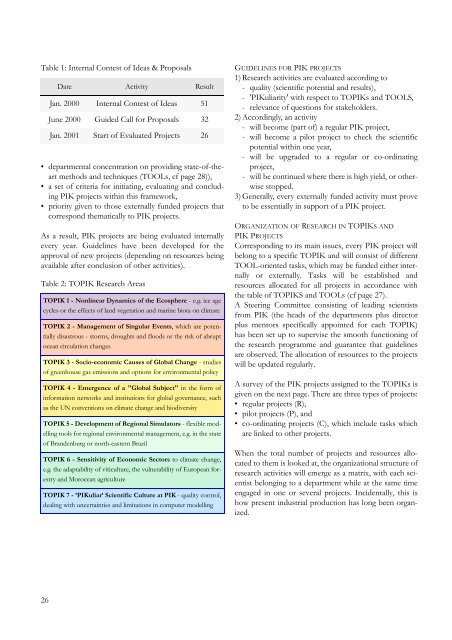PIK Biennial Report 2000-2001 - Potsdam Institute for Climate ...
PIK Biennial Report 2000-2001 - Potsdam Institute for Climate ...
PIK Biennial Report 2000-2001 - Potsdam Institute for Climate ...
You also want an ePaper? Increase the reach of your titles
YUMPU automatically turns print PDFs into web optimized ePapers that Google loves.
Table 1: Internal Contest of Ideas & Proposals<br />
• departmental concentration on providing state-of-theart<br />
methods and techniques (TOOLs, cf page 28)),<br />
• a set of criteria <strong>for</strong> initiating, evaluating and concluding<br />
<strong>PIK</strong> projects within this framework,<br />
• priority given to those externally funded projects that<br />
correspond thematically to <strong>PIK</strong> projects.<br />
As a result, <strong>PIK</strong> projects are being evaluated internally<br />
every year. Guidelines have been developed <strong>for</strong> the<br />
approval of new projects (depending on resources being<br />
available after conclusion of other activities).<br />
26<br />
Date Activity Result<br />
Jan. <strong>2000</strong> Internal Contest of Ideas 51<br />
June <strong>2000</strong> Guided Call <strong>for</strong> Proposals 32<br />
Jan. <strong>2001</strong> Start of Evaluated Projects 26<br />
Table 2: TO<strong>PIK</strong> Research Areas<br />
TO<strong>PIK</strong> 1 - Nonlinear Dynamics of the Ecosphere - e.g. ice age<br />
cycles or the effects of land vegetation and marine biota on climate<br />
TO<strong>PIK</strong> 2 - Management of Singular Events, which are potentially<br />
disastrous - storms, droughts and floods or the risk of abrupt<br />
ocean circulation changes<br />
TO<strong>PIK</strong> 3 - Socio-economic Causes of Global Change - studies<br />
of greenhouse gas emissions and options <strong>for</strong> environmental policy<br />
TO<strong>PIK</strong> 4 - Emergence of a "Global Subject" in the <strong>for</strong>m of<br />
in<strong>for</strong>mation networks and institutions <strong>for</strong> global governance, such<br />
as the UN conventions on climate change and biodiversity<br />
TO<strong>PIK</strong> 5 - Development of Regional Simulators - flexible modelling<br />
tools <strong>for</strong> regional environmental management, e.g. in the state<br />
of Brandenburg or north-eastern Brazil<br />
TO<strong>PIK</strong> 6 - Sensitivity of Economic Sectors to climate change,<br />
e.g. the adaptability of viticulture, the vulnerability of European <strong>for</strong>estry<br />
and Moroccan agriculture<br />
TO<strong>PIK</strong> 7 - ’<strong>PIK</strong>uliar’ Scientific Culture at <strong>PIK</strong> - quality control,<br />
dealing with uncertainties and limitations in computer modelling<br />
GUIDELINES FOR <strong>PIK</strong> PROJECTS<br />
1) Research activities are evaluated according to<br />
- quality (scientific potential and results),<br />
- '<strong>PIK</strong>uliarity' with respect to TO<strong>PIK</strong>s and TOOLS,<br />
- relevance of questions <strong>for</strong> stakeholders.<br />
2) Accordingly, an activity<br />
- will become (part of) a regular <strong>PIK</strong> project,<br />
- will become a pilot project to check the scientific<br />
potential within one year,<br />
- will be upgraded to a regular or co-ordinating<br />
project,<br />
- will be continued where there is high yield, or otherwise<br />
stopped.<br />
3) Generally, every externally funded activity must prove<br />
to be essentially in support of a <strong>PIK</strong> project.<br />
ORGANIZATION OF RESEARCH IN TO<strong>PIK</strong>S AND<br />
<strong>PIK</strong> PROJECTS<br />
Corresponding to its main issues, every <strong>PIK</strong> project will<br />
belong to a specific TO<strong>PIK</strong> and will consist of different<br />
TOOL-oriented tasks, which may be funded either internally<br />
or externally. Tasks will be established and<br />
resources allocated <strong>for</strong> all projects in accordance with<br />
the table of TO<strong>PIK</strong>S and TOOLs (cf page 27).<br />
A Steering Committee consisting of leading scientists<br />
from <strong>PIK</strong> (the heads of the departments plus director<br />
plus mentors specifically appointed <strong>for</strong> each TO<strong>PIK</strong>)<br />
has been set up to supervise the smooth functioning of<br />
the research programme and guarantee that guidelines<br />
are observed. The allocation of resources to the projects<br />
will be updated regularly.<br />
A survey of the <strong>PIK</strong> projects assigned to the TO<strong>PIK</strong>s is<br />
given on the next page. There are three types of projects:<br />
• regular projects (R),<br />
• pilot projects (P), and<br />
• co-ordinating projects (C), which include tasks which<br />
are linked to other projects.<br />
When the total number of projects and resources allocated<br />
to them is looked at, the organizational structure of<br />
research activities will emerge as a matrix, with each scientist<br />
belonging to a department while at the same time<br />
engaged in one or several projects. Incidentally, this is<br />
how present industrial production has long been organized.

















